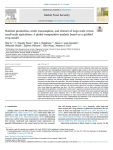Su H., Foster T., Hogeboom R.J., Luna-Gonzalez D.V., Mialyk O., Willaarts B., Wang Y., Krol M.S. (2025). Nutrient production, water consumption, and stresses of large-scale versus small-scale agriculture: a global comparative analysis based on a gridded crop model. Global Food Security, 01/06/2025, vol. 45, p. 100844.
https://doi.org/10.1016/j.gfs.2025.100844
https://doi.org/10.1016/j.gfs.2025.100844
| Titre : | Nutrient production, water consumption, and stresses of large-scale versus small-scale agriculture: a global comparative analysis based on a gridded crop model (2025) |
| Auteurs : | H. Su ; T. Foster ; R.J. Hogeboom ; D.V. Luna-Gonzalez ; O. Mialyk ; B. Willaarts ; Y. Wang ; M.S. Krol |
| Type de document : | Article |
| Dans : | Global Food Security (vol. 45, June 2025) |
| Article en page(s) : | p. 100844 |
| Langues : | Anglais |
| Langues du résumé : | Anglais |
| Catégories : |
Catégories principales 06 - AGRICULTURE. FORÊTS. PÊCHES ; 6.4 - Production Agricole. Système de ProductionThésaurus IAMM SYSTEME DE PRODUCTION ; AGRICULTURE INTENSIVE ; AGRICULTURE EXTENSIVE ; UTILISATION DE L'EAU ; EAU D'IRRIGATION ; PRODUCTION AGRICOLE |
| Résumé : | Agricultural water consumption is the main contributor to water scarcity worldwide, while small-scale and large-scale agriculture have distinguishing characteristics. Significant gaps remain in the process-based agricultural production and water consumption estimates distinguishing small-scale and large-scale agriculture, which inhibits our deep understanding of where, how, and by whom crops are produced and against what water outcomes. We close this gap by leveraging a gridded crop model, covering 61% of the global harvested area using a 2010 baseline. Results show small-scale agriculture accounts for 43% of the total harvested area, however, contributes to relatively less nutrient production despite cultivating more food crops (relative to their total harvested area) than large-scale agriculture. This result challenges the assumption made by existing global scale studies when allocating national agricultural production to small-scale and large-scale agriculture, which (partly) ignores the differences in climate conditions, soil characteristics, input level, and type of irrigation that small-scale versus large-scale agriculture may have. The lower contribution is due to both water and soil fertility stress. Small-scale agriculture overrepresents in water-scarce regions but consumes much less blue water (38%) compared to its harvested area (54%). In water-scarce regions, soil fertility stress causes small-scale agriculture the unproductive green water utilization and a 70?90% unmet crop production potential. Our findings demonstrate the unequal exposure and contribution to water scarcity between small-scale and large-scale agriculture and between food and non-food crops. Understanding such disparities is one of the first and necessary steps toward enhancing the resilience and sustainability of agricultural systems. |
| Cote : | En ligne |
| URL / DOI : | https://doi.org/10.1016/j.gfs.2025.100844 |







